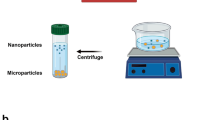Abstract
Chitosan is biocompatible polymer of natural origin widely investigated for applications in drug delivery and regenerative medicine. In this paper, Chitosan’s capability of forming water gelling beads in the presence of non-toxic polyanion was exploited for the loading of two model proteins. Human Serum Albumin (HSA) and porcine trypsin were successfully loaded into Chitosan-tripolyphosphate (TPP) beads. Both proteins were highly incorporated when the crosslinking process was allowed to occur for 24 h at RT. The release profiles of the two proteins were compared and the faster diffusion of trypsin was associated to its smaller molecular weight. Moreover, in vitro degradation experiments, aimed at mimicking the physiological degradation pattern of the beads displayed a complete degradation of the material in almost 30 days. Certainly, the preliminary experimental data acquired in the present work represent a starting study for the promising application of Chitosan-TPP beads for the controlled release of proteins of therapeutic interest.
Access this chapter
Tax calculation will be finalised at checkout
Purchases are for personal use only
Preview
Unable to display preview. Download preview PDF.
Similar content being viewed by others
References
Steinbiichel A (2002) Biopolymers. Vandamme EJ (ed) Volume 5. Polysaccharides~I: polysaccharides from eukaryotes and Volume 6. Polysaccharides II: polysaccharides from prokaryotes. Wiley-VCH Verlag GmbH, Weinheim, Germany
Bravo-Osuna I, Vauthier C, Farabollini A, Palmieri GF, Ponchel G (2007) Mucoadhesion mechanism of Chitosan and thiolated Chitosan-poly(isobutyl cyanoacrylate) core-shell nanoparticles. Biomaterials 28(13):2233–2243
Muzzarelli RAA, Muzzarelli C (2005) Chitosan chemistry: relevance to the biomedical sciences. Adv Adv Polym Sci 186:151–209
Agnihotri SA, Mallikarjuna NN, Aminabhavi TM (2004) Recent advances on Chitosan-based micro-and nanoparticles in drug delivery. J Control Release 100:5–28
Denkbas EB, Ottenbrite RM (2006) Perspectives on: Chitosan drug delivery systems based on their geometries. J Bioact Compat Polym 21(4):351–368
Mi FL, Shyu SS, Lee ST, Wong TB (1999) Kinetic study of chitosan-tripolyphosphate complex reaction and acid-resistive properties of the chitosan-tripolyphosphate gel beads prepared by ni-liqiud curing method. J Polym Sci, Part B: Polym Phys 37:1551
Chiellini F, Bartoli C, Dinucci D, Piras AM, Anderson R, Croucher T (2007) “Bioeliminable Polymeric Nanoparticles for Proteic Drug Delivery”. International Journal of Pharmaceutics 343(l–2):90–99
Piras AM, Chiellini F, Fiumi C, Bartoli C, Chiellini E, Fiorentino B, Farina C (2008) “A New Biocompatible Nanoparticle Delivery System for the Release of Fibrinolytic Drugs”. International Journal of Pharmaceutics 357(1–2):260–271f
Porstmann B, Jung K, Schmechta H, Evers U, Pergande M, Porstmann T, Kramm HJ, Krause H (1989) Measurement of ly sozyme in human body fluids: comparison of various enzyme immunoassay techniques and their diagnostic application. Clin Biochem 22:349–355
Masuda T, Ueno Y, Kitabatake N (2001) Sweetness and enzymatic activity of lysozyme. J Agric Food Chem 49:4937–4941
Shu XZ, Zhu KJ (2002) Controlled drug release properties of ionically crosslinked Chitosan beads: the influence of anion structure. Int J Pharm 233:217–225
Anal AK, Stevens WF, Remunan-Lopez C (2006) Ionotropic crosslinked Chitosan microspheres for controlled release of ampicillin. Int J Pharm 312:166–173
Varum KM, Myhr MM, Hjerde RJN, Smidsrod O (1997) In vitro degradation rates of partially N-acetylated Chitosans in human serum. Carbohydr Res 299:99–101
Pangburn SH, Trescony PV, Heller J (1982) Lysozyme degradation of partially deacetylated chitin, its films and hydrogels. Biomaterials 3:105–108
Nordtveit RJ, Varum KM, Smidsrod O (1994) Degradation of fully water-soluble, partially N-acetylated Chitosans with lysozyme. Carbohydr Polym 23:253–260
Li XF, Nie X, and Tang JG (1998) Anti-autolysis of Trypsin by Modification of Autoly tic Site Argl 17, Biochemical and biophysical research communications 250:235–239
Vajda T, Garai A (1981) Comparison of the effect of calcium(II) and manganese(II) ions on trypsin autolysis. J Inorg Biochem 15(4):307–315
Author information
Authors and Affiliations
Rights and permissions
Copyright information
© 2009 Springer-Verlag Italia, Milan
About this chapter
Cite this chapter
Dash, M., Piras, A.M., Chiellini, F. (2009). Chitosan-Based Beads for Controlled Release of Proteins. In: Hydrogels. Springer, Milano. https://doi.org/10.1007/978-88-470-1104-5_10
Download citation
DOI: https://doi.org/10.1007/978-88-470-1104-5_10
Publisher Name: Springer, Milano
Print ISBN: 978-88-470-1103-8
Online ISBN: 978-88-470-1104-5
eBook Packages: Chemistry and Materials ScienceChemistry and Material Science (R0)




